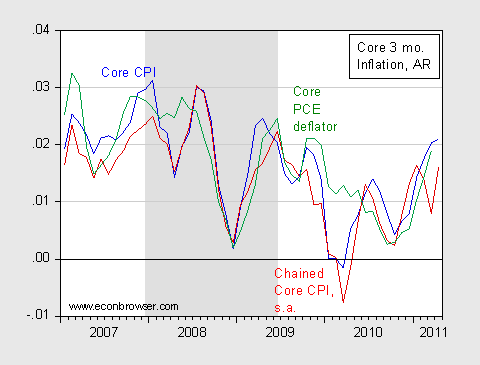A chain-weighted inflation measure takes into account changes in both price and spending patterns. A chain-weighted inflation index measures both changes in the price of goods but also reflects changes in the number of goods bought.
- For example, suppose you buy two goods which are close substitutes – bananas (30p) and apples (30p)
- At this price, you may buy 2 x bananas and 2 x apples.
- Let us assume the price of bananas increased 50% to 45p, but apples stayed the same price 30p.
- This would suggest a jump in the inflation rate. 50%/2 + 0%/2 = 25% average inflation rate
However, if the price of bananas increased, you might just shift to buying apples. Therefore, the price of goods that you actually buy has not changed.
A chain weighted inflation measure would take into account the fact you no longer buy bananas. The prices you actually pay for apples have stayed the same. Therefore, it would give an inflation rate of 0% – very different to the actual CPI rate of 25%.
CPI and COLA (Cost of Living Adjustment)
- In the US and UK, benefit payments are tied to the inflation rate. (In UK we say benefits are index linked).
- In US, benefits are linked to the CPI. This is termed a cost of living adjustment (COLA) (COLA at Social Security Online) This cost of living adjustment could use a chain-weighted measure rather than current CPI.
Chain Weighted Inflation Measure Gives Lower Rate
Chain-weighted inflation measures tend to give a lower inflation rate than standard inflation rates. This is because if goods go up in price, you buy less of them. Therefore these more expensive goods automatically get a lower weighting. However, in the traditional measure of CPI, the weights are not changed (maybe once a year, in US weights were only updated every ten years, now every two years)
In the US, the personal consumption expenditure deflator PCE is calculated using a chained Fisher index. The standard CPI is calculated using a Laspeyres style index.
 source: cpi
source: cpi
Problems of Using Chain Weighted Inflation Measures
- It would mean benefits rise at a lower rate.
- Some groups of people may have greater difficulty in substituting to cheaper goods. For example, if the price of bus fares rise, mobile adults may shift to using cars, but young or old people may be stuck with paying higher bus fares.
- Some argue inflation currently underestimates living costs rather than over-estimating costs. e.g. food prices excluded from core inflation measures. Using chain-weighted measure could lead to falling living costs.
Related
- Chained CPI at Econbrowser
- Inflation at BLS

This always sounds so scary to me but I realize always that is very useful. But anyway, I like the Fisher Index method.
Kudos. Excellently done. Excellent learning from this piece.
Clear and concise.
The last line is confusing. Do you mean using this figure might lower living costs or that it will report lower living costs that would be seen as the same using the previous method?
There is an assumption embedded in the technique that substitution will always be to reduce the percentage change in the basket, regardless of whether the the new item costs more than the item that was replaced. It is all about gaming the numbers.